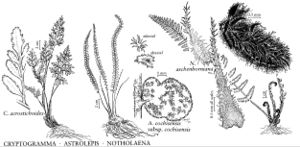Difference between revisions of "Notholaena aschenborniana"
Linnaea 20: 417. 1847.
FNA>Volume Importer |
imported>Volume Importer |
||
| (7 intermediate revisions by 2 users not shown) | |||
| Line 6: | Line 6: | ||
|place=20: 417. 1847 | |place=20: 417. 1847 | ||
|year=1847 | |year=1847 | ||
| + | }} | ||
| + | |special_status={{Treatment/ID/Special_status | ||
| + | |code=F | ||
| + | |label=Illustrated | ||
}} | }} | ||
|basionyms= | |basionyms= | ||
| Line 11: | Line 15: | ||
|name=Cheilanthes aschenborniana | |name=Cheilanthes aschenborniana | ||
|authority=(Klotzsch) Mettenius | |authority=(Klotzsch) Mettenius | ||
| − | }}{{Treatment/ID/Synonym | + | |rank=species |
| + | }} {{Treatment/ID/Synonym | ||
|name=Chrysochosma aschenborniana | |name=Chrysochosma aschenborniana | ||
|authority=(Klotzsch) Pichi-Sermolli | |authority=(Klotzsch) Pichi-Sermolli | ||
| + | |rank=species | ||
}} | }} | ||
|hierarchy=Pteridaceae;Notholaena;Notholaena aschenborniana | |hierarchy=Pteridaceae;Notholaena;Notholaena aschenborniana | ||
| Line 22: | Line 28: | ||
}}<!-- | }}<!-- | ||
| − | --><span class="statement" id="st- | + | --><span class="statement" id="st-undefined" data-properties=""><b>Stem </b>scales concolored, margins black, undifferentiated, thick, ciliate. <b>Leaves</b> 8–35 cm. <b>Petiole</b> black, much shorter than blade, rounded adaxially, covered with ciliate and stellate scales. <b>Blade</b> lanceolate, usually 2-pinnate, 3–6 times longer than wide, abaxially with whitish or yellowish farina completely concealed by overlapping ciliate and deeply dissected stellate scales, adaxially with scattered stellate scales; basal pinnae equal to or slightly smaller than adjacent pair, ± equilateral, proximal basiscopic pinnules not greatly enlarged. <b>Ultimate</b> segments sessile to subsessile, narrowly adnate to costae; segment margins slightly recurved, rarely concealing sporangia. <b>Sporangia</b> containing 32 spores. n = 2n = 90, apogamous.</span><!-- |
-->{{Treatment/Body | -->{{Treatment/Body | ||
| + | |phenology=Sporulating summer–fall. | ||
|habitat=Rocky slopes and cliffs, apparently confined to limestone | |habitat=Rocky slopes and cliffs, apparently confined to limestone | ||
|elevation=300–1900 m | |elevation=300–1900 m | ||
|distribution=Ariz.;Tex.;Mexico. | |distribution=Ariz.;Tex.;Mexico. | ||
| − | |discussion=<p>Although Notholaena aschenborniana is often described as nonfarinose, the abaxial glandular farina characteristic of all species of Notholaena as defined here is present beneath the dense covering of scales. All individuals examined chromosomally by M. D. Windham (unpublished data) were apogamous triploids that apparently arose through autopolyploidy. Further investigation is necessary to determine whether or not 64-spored, diploid populations of N. aschenborniana are still extant.</p> | + | |discussion=<p>Although <i>Notholaena aschenborniana</i> is often described as nonfarinose, the abaxial glandular farina characteristic of all species of <i>Notholaena</i> as defined here is present beneath the dense covering of scales. All individuals examined chromosomally by M. D. Windham (unpublished data) were apogamous triploids that apparently arose through autopolyploidy. Further investigation is necessary to determine whether or not 64-spored, diploid populations of <i>N. aschenborniana</i> are still extant.</p> |
|tables= | |tables= | ||
|references= | |references= | ||
| Line 37: | Line 44: | ||
-->{{#Taxon: | -->{{#Taxon: | ||
name=Notholaena aschenborniana | name=Notholaena aschenborniana | ||
| − | |||
|authority=Klotzsch | |authority=Klotzsch | ||
|rank=species | |rank=species | ||
| Line 44: | Line 50: | ||
|basionyms= | |basionyms= | ||
|family=Pteridaceae | |family=Pteridaceae | ||
| + | |phenology=Sporulating summer–fall. | ||
|habitat=Rocky slopes and cliffs, apparently confined to limestone | |habitat=Rocky slopes and cliffs, apparently confined to limestone | ||
|elevation=300–1900 m | |elevation=300–1900 m | ||
| Line 50: | Line 57: | ||
|publication title=Linnaea | |publication title=Linnaea | ||
|publication year=1847 | |publication year=1847 | ||
| − | |special status= | + | |special status=Illustrated |
| − | |source xml=https:// | + | |source xml=https://bitbucket.org/aafc-mbb/fna-data-curation/src/2e0870ddd59836b60bcf96646a41e87ea5a5943a/coarse_grained_fna_xml/V2/V2_386.xml |
|genus=Notholaena | |genus=Notholaena | ||
|species=Notholaena aschenborniana | |species=Notholaena aschenborniana | ||
| − | |||
| − | |||
| − | |||
| − | |||
| − | |||
| − | |||
| − | |||
| − | |||
| − | |||
| − | |||
| − | |||
| − | |||
| − | |||
| − | |||
| − | |||
| − | |||
| − | |||
| − | |||
| − | |||
| − | |||
| − | |||
| − | |||
| − | |||
| − | |||
| − | |||
| − | |||
| − | |||
| − | |||
| − | |||
}}<!-- | }}<!-- | ||
-->[[Category:Treatment]][[Category:Notholaena]] | -->[[Category:Treatment]][[Category:Notholaena]] | ||
Latest revision as of 21:23, 5 November 2020
Stem scales concolored, margins black, undifferentiated, thick, ciliate. Leaves 8–35 cm. Petiole black, much shorter than blade, rounded adaxially, covered with ciliate and stellate scales. Blade lanceolate, usually 2-pinnate, 3–6 times longer than wide, abaxially with whitish or yellowish farina completely concealed by overlapping ciliate and deeply dissected stellate scales, adaxially with scattered stellate scales; basal pinnae equal to or slightly smaller than adjacent pair, ± equilateral, proximal basiscopic pinnules not greatly enlarged. Ultimate segments sessile to subsessile, narrowly adnate to costae; segment margins slightly recurved, rarely concealing sporangia. Sporangia containing 32 spores. n = 2n = 90, apogamous.
Phenology: Sporulating summer–fall.
Habitat: Rocky slopes and cliffs, apparently confined to limestone
Elevation: 300–1900 m
Distribution

Ariz., Tex., Mexico.
Discussion
Although Notholaena aschenborniana is often described as nonfarinose, the abaxial glandular farina characteristic of all species of Notholaena as defined here is present beneath the dense covering of scales. All individuals examined chromosomally by M. D. Windham (unpublished data) were apogamous triploids that apparently arose through autopolyploidy. Further investigation is necessary to determine whether or not 64-spored, diploid populations of N. aschenborniana are still extant.
Selected References
None.
